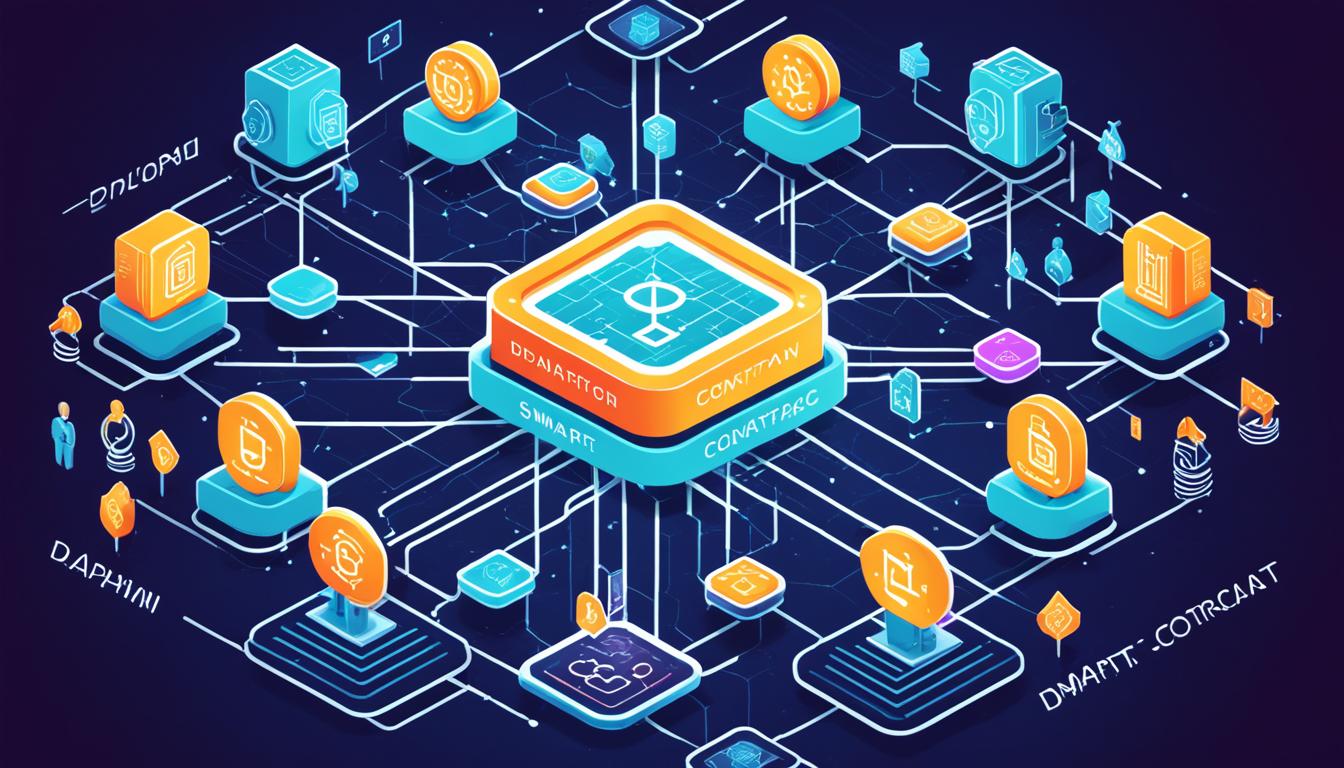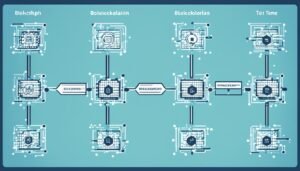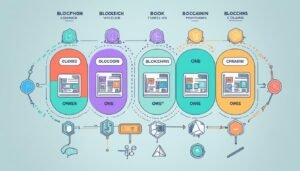Smart Contracts and Decentralized Applications (DApps)
Smart contracts are self-executing contracts with their terms written into code on a blockchain. They first appeared on the Ethereum (ETH) network and changed how we do transactions. They automate complex processes, cut down on manual work, and speed up settlements.
These contracts remove the need for middlemen, making things more efficient and cutting down on disputes. Many blockchain networks, like Filecoin (FIL), are now adding support for smart contract development. Blockchain technology platforms like Aave and Melonport use these contracts to make decentralized finance smoother. Aave lets users lend, borrow, and stake cryptocurrency. Melonport offers decentralized crypto asset management.
Decentralized applications (dapps) use blockchain to spread control and work without a single authority. For example, BitTorrent, linked with the TRON (TRX) blockchain, and Uniswap, a decentralized exchange on Ethereum, show how dapps work. Uniswap lets users trade cryptocurrencies safely and openly.
Dapps cover a wide range of uses, from peer-to-peer transactions to finance, gaming, and social networking. They make the digital world more secure and transparent, giving users control over their data.
But, dapps also face challenges. In 2022, there were 312 hacks and vulnerabilities that led to losses of about $48 billion. Even though financial losses dropped by 96% to $1.9 billion in 2023, the number of incidents went up by 17.3%. This trend kept going in the first quarter of 2024, with losses increasing by 9% to $407 million.
Despite these issues, smart contracts and dapps are still growing in potential. They offer new solutions that are changing many industries with blockchain technology.
Exploring the World of Smart Contracts: Key Concepts and Use Cases
Smart contracts are agreements that run on the Ethereum blockchain. They work without middlemen and follow set rules. They make sure smart contract security is top-notch by being unchangeable and clear.
To make a smart contract, you connect to a blockchain, fund an account with cryptocurrency, write the contract with solidity programming, and then deploy it.
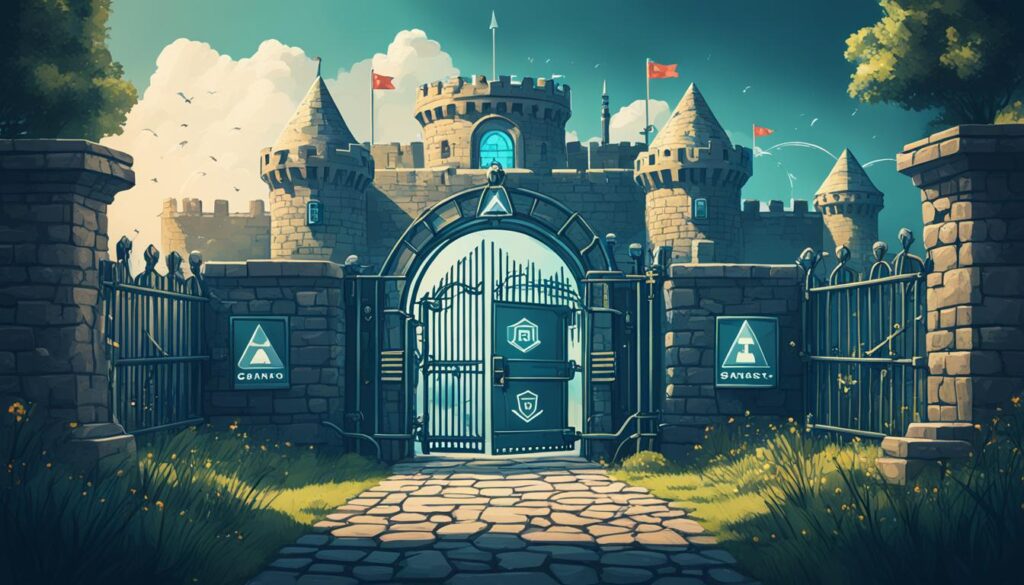
Smart contracts are great at handling automated transactions and making secure digital agreements in many areas. They’re key to new financial systems like DeFi, which has grown to billions in value.
In the U.S., some states see the value in smart contracts. For example, Delaware passed Senate Bill 69. This lets businesses use blockchain, leading to the creation of DAOs.
Smart contracts are vital for Web3. They power DApps and change how industries work.
Here are some big ways smart contracts are used:
- Financial Services: They make trades settle fast, turn stocks into tokens, and handle automated transactions.
- Real Estate: They list properties, transfer ownership, and turn homes into tokens, like a house sold in Florida for $175,000.
- Gaming: They use NFTs and smart contracts to manage game items, changing the $100 billion gaming world.
- Logistics: They speed up payments, make things clearer, and automate checks.
As smart contracts grow, so do their uses. They cut down on waste and fraud in many areas. They create a safe space for digital deals, changing how businesses work.
| Use Case | Impact of Smart Contracts |
|---|---|
| Financial Services | They swap slow manual steps for quick automated ones, making things more efficient. |
| Real Estate | They make listing properties, storing deeds, and transferring ownership easier. |
| Gaming | They let players keep value in game items with NFTs and smart contracts. |
| Logistics | They speed up payments and make things clearer. |
Transforming Business Operations with Smart Contracts: Best Practices
Smart contracts are changing how businesses work by making things automatic, faster, and cheaper. Nick Szabo first talked about them in 1994 as digital transaction mechanisms. With platforms like Ethereum, they became real. These contracts make deals happen on their own, cutting costs and time.
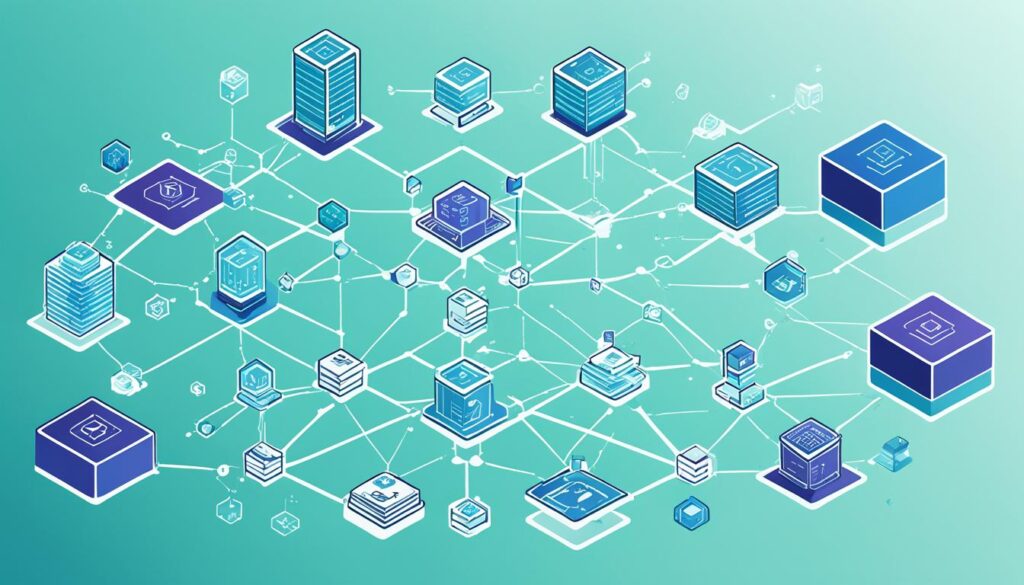
To use smart contracts well, businesses need to follow some key steps. First, test them before you start using them. This helps find and fix problems, making sure everything is clear and works as it should. Keeping up with new tech and security updates is also important for strong contracts.
Smart contracts make things more open and trustworthy. They let everyone check the rules on the blockchain. Finance, real estate, supply chain, and healthcare can really benefit from them. For example, buying and selling property can be faster and safer with these contracts. DApps use them for direct transactions, cutting out middlemen.
| Benefits | Examples |
|---|---|
| Cost Savings | Banks and financial institutions could save up to $27 billion annually by 2030. |
| Speed | Smart contracts speed up agreement execution, completing transactions in minutes. |
| Transparency | All parties can verify contract terms on the blockchain. |
| Error Reduction | Automation and code-based execution lower the risk of errors. |
| Industry Applications | Finance, real estate, supply chain management, healthcare |
To use smart contracts in business, focus on security and the flexibility of Ethereum contracts. Be aware of the challenges like standardization and scalability. This way, businesses can enjoy the benefits of smart contracts. They can work more efficiently, save money, and build trust.
Navigating Legal Waters: Smart Contracts and Compliance
Smart contracts are becoming more popular, making it key to understand legal compliance. They work on blockchain, making things more efficient and cutting down on fraud. But, they also bring new rules that need to be followed.
Understanding blockchain compliance is vital, especially since it affects different industries in different ways. For example, finance has more rules to follow than other areas. Smart contracts in DeFi, like lending and trading, make following these rules even harder.
To figure out how decentralized a protocol is, we look at six things: how much outside influence it has, how much control it has on its own, and who can join in. These factors help us see what rules apply and the risks for those working with the system.
- Permissionless: External players have no control over the protocol.
- Semi-Permissionless: Limited control is exercised by external players.
- Permission-Based: Extensive control by external parties is enabled.
When we talk about decentralized governance and blockchain compliance, it changes how we see legal duties. For instance, some protocols don’t need outside help but others do. This affects how they’re seen legally.
| Protocol Type | Characteristics | Compliance Risks |
|---|---|---|
| DeFi Protocols | Value Exchange Data | High |
| Governance Protocols | Decision-Making Data | Moderate |
| zk-Proof Protocols | Digital Identity Data | Low |
Smart contracts are efficient but can be tough to follow the law. It’s important for everyone to work with legal experts. This way, they can make sure these contracts follow the law and still use blockchain’s benefits.
Decentralized Applications (DApps) Architecture Demystified
Decentralized applications, or dApps, are open-source software that run on blockchain networks. They don’t use central servers like traditional apps do. Instead, they use a decentralized setup for better security and transparency. To build a dApp, you need to know and use several key parts, each important for the app’s structure.
The consensus mechanism is a key part of dApp development. It can be proof of work (PoW) or proof of stake (PoS). These methods help the network agree on data or transactions without a single boss. For example, Ethereum dapps use PoW to keep things running smoothly.
Smart contracts are the heart of many blockchain apps. They automate tasks and follow rules set on the blockchain. Solidity is a key language for writing these contracts, mainly for Ethereum. Rust is also big, especially on Solana.
DApps have many uses, like in DeFi, gaming, social media, and supply chain management. For instance, Chainlink helps with Oracle networks, TraceDonate with charity, and Minds with social media. Solutions like IPFS and Filecoin help manage data off the blockchain, solving problems of scale and cost.
For the frontend, JavaScript libraries like Web3.js and Ethers.js are popular. They help connect with the blockchain and smart contracts, making things easier for users. DeFi dApps often use oracles like Chainlink and UMA to bring in outside data.
Most dApps use central hosting, but Fleek offers decentralized options. Choosing the right wallet is also key in dApp development. There are many types, from browser-based to custodial and non-custodial wallets.
Services like Alchemy, QuickNode, Tatum, Ankr, and Infura help developers by giving them access to remote nodes. This makes building dApps easier. Decentralized indexing protocols like The Graph also help developers get data efficiently.
Even with their benefits, like being tough to take down and keeping data safe, dApps face challenges. These include upkeep, growing big enough, dealing with network delays, and making things easy for users. Knowing these issues and how to solve them is crucial for improving dApp development and using blockchain more widely.
Unlocking the Power of DApps: Real-World Use Cases
DApps have a wide range of uses, changing how we do things, manage services, and handle money. For example, Uniswap is a decentralized exchange that lets people trade DeFi tokens easily. It uses a system where users add their own money to help others trade.
CryptoKitties, a game on the blockchain, showed how NFTs and blockchain can be used for digital items in 2017. It was a big deal back then.
Aave is another big name in DApps. It’s a finance tool that lets people lend and borrow digital assets easily. This cuts out the middlemen and makes things more accessible.
Melonport is also changing the game with its asset management tools. It uses blockchain to make sure everything is safe and clear.
BitTorrent is famous for sharing files between people. Now, it’s using DApps to share data in a new way. MakerDAO has also made a stablecoin called DAI. It’s backed by other cryptocurrencies and runs on smart contracts, showing how DApps can make finance more stable and trustworthy.
Tokenization and security tokens are big deals for DApps too. They change how we deal with assets, making it faster and cheaper. This helps businesses grow globally and build strong communities.
With tools like decentralized exchanges, buying and selling things is easier and cheaper. DApps work on big networks and use smart contracts. This means they cut out middlemen, lower fraud risks, and are clear about everything on a public ledger.
Decentralized Finance (DeFi), with platforms like Uniswap and Aave, has changed traditional finance. It focuses on being safe, clear, and easy for users.
Even with ups and downs in 2022, the future of DApp platforms and DeFi looks bright. These examples show how security tokens and tokenization can change the economy.
DApp use cases show a bright future with more efficiency, access, and security for everyone. As more areas use these technologies, we’ll see more transparency, fewer middlemen, and easier access to global markets.
Securing Decentralized Applications: Best Practices and Strategies
The growth of decentralized applications (dApps) and the blockchain market is huge. It’s expected to hit $469.49 billion by 2030. With over 2.37 million daily users in 2022, making these apps secure is crucial.
For security of crypto smart contracts, we need strong practices. Regular checks by security experts are key, as seen with Compound Finance. In 2016, The DAO’s code mistake caused big financial losses, showing the importance of secure coding.
Important dapp security best practices include:
- Regular security audits by reputable firms
- Secure coding standards
- Testing and verification
- Data encryption in smart contracts
- Access control like RBAC or ABAC
- Bug bounty programs and community help
- Keeping contracts updated
Strong auditing and multi-factor authentication are key for security. DEXs use regular reviews and bug bounty programs to build trust and security in DeFi.
For blockchain security, protecting user info and stopping identity theft is important. This is done with decentralized identity solutions.
Securing dApps is ongoing and requires effort. Tools like Ganache and Truffle help with Ethereum development. Solidity programming and modular code make dApps more secure. Smart contract security is crucial, as they can have bugs like buffer overflows.
With careful work and community help, we can make dApps safer. This protects the growing blockchain world.
Using a test-driven development (TDD) approach helps make smart contracts reliable and secure. This is key for the success and safety of dApps in finance, supply chain, gaming, and sharing platforms.
Decentralized Applications Interoperability: Breaking Down Silos
There’s a big need for decentralized apps to work well across different blockchain networks. This lets cross-chain dapps run smoothly without being stuck in one blockchain world. By making apps work together, developers and users can use many blockchain networks at once. This makes decentralized tech more useful.
New solutions are coming up to solve these problems. Things like atomic swaps, sidechains, and cross-chain bridges are key. They help different blockchain networks talk to each other, making it easier to share assets and data. For example, Polkadot Substrate lets developers create blockchains that easily connect to the Polkadot network.
The Inter-Blockchain Communication (IBC) protocol by the Interchain Foundation helps with things like decentralized exchanges and cross-chain lending. But, making all blockchains work together is hard because of many reasons. Things like different rules, languages, and security worries stand in the way. Groups like the Interledger Protocol (ILP) and the Blockchain Interoperability Alliance (BIA) are working to fix these issues.
Being able to work together is key for cross-chain dapps. It helps with teamwork and brings new ideas to the table. As we get better at talking between blockchains, we’ll see big changes in things like finance, supply chains, and identity checks. Fixing these problems is very important.
| Interoperability Solutions | Use Cases | Benefits |
|---|---|---|
| Atomic Swaps | Asset Exchanges Without Counterparty Risk | Eliminates Middlemen, Reduces Costs |
| Cross-Chain Bridges | Verifiable Asset and Data Transfer | Enhanced Security, Efficient Transfers |
| IBC Protocol | Decentralized Exchanges, Cross-Chain Lending | Improved Utility, Expanded Functionality |
| Polkadot Substrate | Custom Blockchains Connectivity | Simplified Interoperability, Flexibility |
Revolutionizing Traditional Industries: Impact of Smart Contracts and DApps
The digital age is bringing big changes with smart contracts and decentralized applications (DApps). Ethereum now has over 3,000 DApps, showing a big step in blockchain’s impact. These technologies bring new benefits like better transparency, efficiency, and decentralization.
Smart contracts and DApps are changing how we manage supply chains. For example, VeChain and OriginTrail use Ethereum’s blockchain for real-time tracking in industries like pharmaceuticals and food. This makes the supply chain safer, cuts down on mistakes, and builds trust.
In healthcare, Ethereum-based DApps keep medical records safe and manage patient data well. They make sure clinical trials work smoothly and keep patient info private. This helps improve care and lowers costs.
For governance, OpenLaw is leading the way with smart contracts for legal agreements and following rules. These contracts make government tasks more open and efficient. They change how we handle and check on administrative work.
Gaming is also getting a lot from this tech. Games like Axie Infinity and Decentraland use NFTs for new ways to own, trade, and make money from game items. Some items are even selling for thousands of dollars.
Smart contracts are key to many DApps. They offer top-notch security and are set in stone once on the blockchain. This means they can’t be changed or hacked. They automate tasks, cutting costs and making things run smoother.
The rise of DApps in traditional industries is a big deal. With about $90 billion in value locked in Ethereum-based DApps, it shows blockchain is here to stay. It’s not just a trend; it’s changing the future of business.
Future Trends: Evolution of Smart Contracts and Decentralized Applications
The evolution of smart contracts and decentralized applications is changing the blockchain world. A big focus now is on making decentralized app development better, thanks to new blockchain technology. Many developers are working on solving problems that let different blockchains work together. Projects like Polkadot and Cosmos are building networks that connect blockchains.
In DeFi, new ideas keep coming. Smart contracts are key for many DeFi apps, making sure transactions are safe and secure. Now, advanced Oracle solutions are being used more often. These solutions provide secure and reliable data, making DeFi apps stronger.
| Trend | Details |
|---|---|
| Privacy-Preserving Smart Contracts | More smart contracts are focusing on privacy, using zero-knowledge proofs. |
| Energy-Efficient Contracts | Many new smart contracts are made with saving energy in mind. |
| Secure Smart Contracts | There’s more focus on making smart contracts secure with formal checks and audits. |
Now, making smart contracts ethical and sustainable is important. Using zero-knowledge proofs and other privacy tech is becoming common. This shows the industry’s effort to keep user data safe and private.
Ethereum 2.0, Polkadot, and Cardano are leading the way in smart contract tech. They’re working on making things faster and more efficient. New tech like state channels and sidechains is helping DApps work better. Off-chain computation is also solving big problems by doing complex tasks outside the blockchain.
The smart contracts market was worth $1.71 billion in 2023 and is expected to grow to $2.14 billion in 2024. By 2032, it could hit $12.55 billion, growing at 24.7% each year. As more industries use these technologies, we’ll see DApps connect more and automate more tasks. Adding AI and machine learning to smart contracts will make them even better at what they do.
Rules are changing to keep up with smart contracts becoming more popular. This shows how important it is to follow the law in this fast-changing field. Being able to work together across different blockchains is key. It lets smart contracts use the best parts of each blockchain.
Smart contracts and DApps bring many benefits like being clear, independent, saving money, and working well. They update automatically and are more secure. This makes them useful in insurance, digital identity, and protecting intellectual property. They’re becoming a big part of the future of the digital economy.
Conclusion
Smart contracts and decentralized applications (DApps) are changing how we handle data and transactions online. They use blockchain technology for a secure, clear, and quick way to work in fields like finance and supply chain.
Smart contracts can make agreements automatic, cutting down on human work and removing middlemen. But, they face issues like security, working together with other systems, and following the law. For example, if smart contracts have bugs, they could cause big financial problems.
DApps are making the industry more decentralized, with Ethereum at the forefront. But, many DApps still use central services for some tasks. New tech like CosVM is helping by making it easier for different systems to work together and supporting more programming languages.
The future of DApps and smart contracts will be huge, changing digital interactions and services a lot. As these technologies get better and more people use them, they will create new ways to do transactions and manage data. This will make blockchain a key part of our digital future.
FAQ
What are smart contracts and decentralized applications (DApps)?
Smart contracts are self-executing contracts with their terms written in code. They live on a blockchain. DApps use blockchain tech, often with smart contracts, to run without a central authority.
How do smart contracts work?
Smart contracts execute automatically when certain conditions are met. They run on blockchain tech for their immutability and transparency.
What blockchain technologies facilitate smart contract development?
Ethereum is a top choice for smart contract development, supporting Solidity programming. Filecoin also supports smart contracts.
What are some common use cases for smart contracts?
Smart contracts automate workflows, keep records transparent, and cut down on fraud. They’re used in many industries for tasks like managing incentives, automating processes, and secure agreements.
What best practices should businesses follow when integrating smart contracts?
Companies should test smart contract code for bugs, make sure terms are clear and enforceable, and keep up with blockchain tech and security standards.
How do smart contracts intersect with legal compliance?
Making sure smart contracts follow the law means dealing with enforceability, jurisdiction, and legality. It’s important to work with legal experts to make sure agreements are both right for tech and the law.
What is involved in developing a DApp?
Developing a DApp means knowing about blockchain consensus like proof of work and proof of stake. It also means having a decentralized governance model. DApps can be for finance, social media, or gaming.
Can you provide real-world examples of DApps?
Examples of DApps include BitTorrent for sharing files, Aave for finance, Melonport for managing assets, and Uniswap for exchanging cryptocurrency. These DApps make key services and financial transactions more decentralized and automated.
How can developers secure decentralized applications and smart contracts?
To secure DApps and smart contracts, use regular audits, follow secure coding standards, test thoroughly, and keep up with security news. Joining bug bounty programs can also help spot issues early.
What is the importance of interoperability in DApps?
Interoperability lets DApps work across different blockchains, creating a more connected ecosystem. Protocols for cross-chain communication help break down network barriers, making it easier for users to interact with various DApps.
How are smart contracts and DApps transforming traditional industries?
They bring more transparency, efficiency, and decentralization to areas like supply chain, healthcare, and corporate governance. This shift towards decentralized models is driven by blockchain tech integration.
What future trends are anticipated for smart contracts and DApps?
We expect to see more adoption, better cross-chain work, and improved user experiences. Tech companies and the finance sector are getting on board, hinting at future advances in scalability, interoperability, and sustainability.

